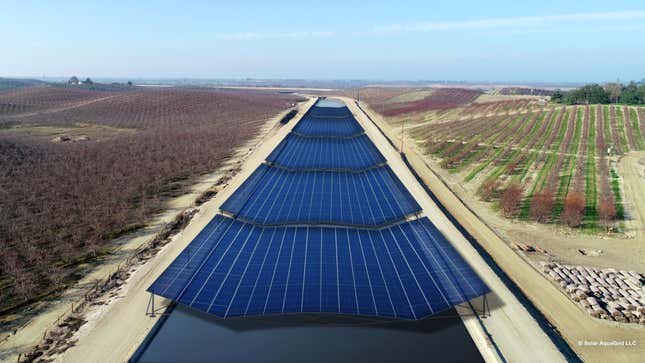
A water and electric utility in central California will install a first-of-its-kind network of solar panels on water canals. Turlock Irrigation District (TID) has secured a $20 million grant from the state to pursue the first-in-the-nation project, which could serve a beneficial double whammy: create renewable energy and save some water in the process.
Project Nexus is based off an analysis published last year in Nature Sustainability, which put some real numbers behind the idea that solar panels over canals could do some good. A lot of water in California wends its way through the state’s 4,000 miles (6,437 kilometers) of open delivery canals that comprise the aqueduct system, transporting water supply from the Sierra Nevada mountains and northern parts of the state to reservoirs, lakes, hydropower plants, and farms. The water supply in the state is already under serious dual threats from overuse and climate change, so every drop counts. And these exposed canals have a serious flaw: They allow some of that precious water to evaporate.
Covering all the canals in the state with solar panels, last year’s analysis found, could save 63 billion gallons of water annually—about the amount needed to irrigate 50,000 acres of farmland or to supply 2 million people with their water needs. (California has 9 million acres of farmland, so this saved water isn’t exactly a panacea to the state’s water overuse—but in a drought, every drop counts.) Those panels, the study’s authors calculated, could supply 13 gigawatts of solar energy, about a sixth of the state’s total energy needs. The water’s cooling effect, in turn, could help keep those solar panels working more effectively, since solar panels lose some efficiency on very hot days.
This project would only cover two small segments of canals in Stanislaus County outside of Modesto, generating, the utility said, enough power for around 100,000 homes. But TID said that the trial, scheduled to begin construction this fall and be completed in 2024, is intended to serve as “proof-of-concept” of how the panels work and how much installation and upkeep costs, with the idea to expand the idea to other areas of the state.
Figuring out how to maximize space around and under solar arrays is nothing new. There’s a growing practice known as agrivoltaics that seeks to elevate solar panels on farmland to allow agricultural activity to still occur, while floating solar panels have been deployed in places like Japan and Singapore. But constructing solar panels as a protection measure for irrigation canals is a new idea. It won’t fix the West’s serious water use problems or the mounting threat climate change poses to water supply, but it does represent the kind of creative solution California needs to explore as it stares down a water-scarce future.
“A lot of water gets evaporated just because we don’t put a lid on it,” Brandi McKuin, the paper’s lead author and a postdoctoral researcher at University of California, Santa Cruz, told Gizmodo last year. Makes sense!